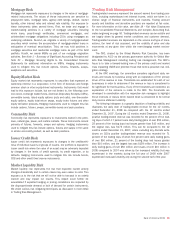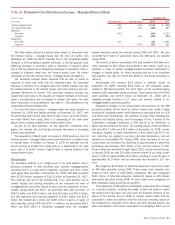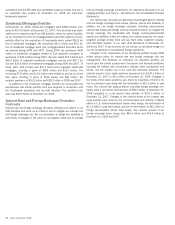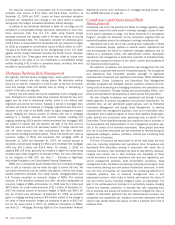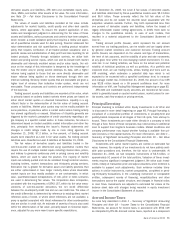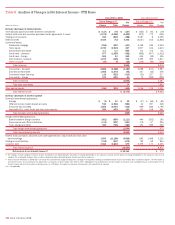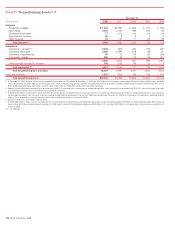Bank of America 2008 Annual Report Download - page 96
Download and view the complete annual report
Please find page 96 of the 2008 Bank of America annual report below. You can navigate through the pages in the report by either clicking on the pages listed below, or by using the keyword search tool below to find specific information within the annual report.of the key variables could impact net income. Separate from the possible
future impact to net income from input and model variables, the value of
our lending portfolio and market sensitive assets and liabilities may
change subsequent to the balance sheet measurement, often sig-
nificantly, due to the nature and magnitude of future credit and market
conditions. Such credit and market conditions may change quickly and in
unforeseen ways and the resulting volatility could have a significant,
negative effect on future operating results. These fluctuations would not
be indicative of deficiencies in our models or inputs.
Allowance for Credit Losses
The allowance for credit losses, which includes the allowance for loan
and lease losses and the reserve for unfunded lending commitments,
represents management’s estimate of probable losses inherent in the
Corporation’s lending activities excluding those measured at fair value in
accordance with SFAS 159. Changes to the allowance for credit losses
are reported in the Consolidated Statement of Income in the provision for
credit losses. Our process for determining the allowance for credit losses
is discussed in the Credit Risk Management section beginning on page
61 and Note 1 – Summary of Significant Accounting Principles to the
Consolidated Financial Statements. Due to the variability in the drivers of
the assumptions made in this process, estimates of the portfolio’s
inherent risks and overall collectability change with changes in the
economy, individual industries, countries and individual borrowers’ or
counterparties’ ability and willingness to repay their obligations. The
degree to which any particular assumption affects the allowance for credit
losses depends on the severity of the change and its relationship to the
other assumptions.
Key judgments used in determining the allowance for credit losses
include: (i) risk ratings for pools of commercial loans and leases,
(ii) market and collateral values and discount rates for individually eval-
uated loans, (iii) product type classifications for consumer and commer-
cial loans and leases, (iv) loss rates used for consumer and commercial
loans and leases, (v) adjustments made to assess current events and
conditions, (vi) considerations regarding domestic and global economic
uncertainty, and (vii) overall credit conditions.
Our allowance for loan and lease losses is sensitive to the risk rating
assigned to commercial loans and leases. Assuming a downgrade of one
level in the internal risk rating for commercial loans and leases and rated
under the internal risk rating scale, except loans and leases already risk
rated Doubtful as defined by regulatory authorities, the allowance for loan
and lease losses would increase by approximately $2.7 billion at
December 31, 2008. The allowance for loan and lease losses as a per-
centage of total loans and leases at December 31, 2008 was 2.49 per-
cent and this hypothetical increase in the allowance would raise the ratio
to approximately 2.78 percent. Our allowance for loan and lease losses is
also sensitive to the loss rates used for the consumer and commercial
portfolios. A 10 percent increase in the loss rates used on the consumer
and commercial loan and lease portfolios covered by the allowance would
increase the allowance for loan and lease losses at December 31, 2008
by approximately $2.0 billion, of which $1.6 billion would relate to con-
sumer and $440 million to commercial.
SOP 03-3 requires acquired impaired loans to be recorded at fair
value and prohibits “carrying over” or the creation of valuation allowances
in the initial accounting of loans acquired in a transfer that are within the
scope of this SOP. However, subsequent decreases to the expected prin-
cipal cash flows from the date of acquisition will result in a charge to
provision for credit losses and a corresponding increase to allowance for
loan and lease losses. Our SOP 03-3 portfolio is also subjected to stress
scenarios to evaluate the potential impact given certain events. A one
percent decrease in the expected principal cash flows could result in an
impairment of the portfolio of approximately $400 million, of which approx-
imately $250 million would be related to our discontinued real estate
portfolio.
These sensitivity analyses do not represent management’s expect-
ations of the deterioration in risk ratings or the increases in loss rates
but are provided as hypothetical scenarios to assess the sensitivity of the
allowance for loan and lease losses to changes in key inputs. We believe
the risk ratings and loss severities currently in use are appropriate and
that the probability of a downgrade of one level of the internal risk ratings
for commercial loans and leases within a short period of time is remote.
The process of determining the level of the allowance for credit losses
requires a high degree of judgment. It is possible that others, given the
same information, may at any point in time reach different reasonable
conclusions.
Mortgage Servicing Rights
MSRs are nonfinancial assets that are created when the underlying mort-
gage loan is sold and we retain the right to service the loan. We account
for consumer MSRs at fair value with changes in fair value recorded in the
Consolidated Statement of Income in mortgage banking income.
Commercial-related and residential reverse mortgage MSRs are
accounted for using the amortization method (i.e., lower of cost or mar-
ket) with impairment recognized as a reduction to mortgage banking
income. At December 31, 2008, our total MSR balance was $13.1 bil-
lion.
We determine the fair value of our consumer MSRs using a valuation
model that calculates the present value of estimated future net servicing
income. The model incorporates key economic assumptions including
estimates of prepayment rates and resultant weighted average lives of
the MSRs and the option adjusted spread (OAS) levels. These variables
can, and generally do, change from quarter to quarter as market con-
ditions and projected interest rates change. These assumptions are sub-
jective in nature and changes in these assumptions could materially
impact our net income. For example, decreasing the prepayment rate
assumption used in the valuation of our consumer MSR by 10 percent
while keeping all other assumptions unchanged could have resulted in an
estimated increase of $786 million in mortgage banking income at
December 31, 2008.
We manage potential changes in the fair value of MSRs through a
comprehensive risk management program. The intent is to mitigate the
effects of changes in MSRs fair value through the use of risk manage-
ment instruments. To reduce the sensitivity of earnings to interest rate
and market value fluctuations, certain derivatives such as options, secu-
rities and interest rate swaps may be used as economic hedges of the
MSRs, but are not designated as hedges under SFAS 133. These
derivatives are marked to market and recognized through mortgage bank-
ing income. The impact provided above does not reflect any hedge strat-
egies that may be undertaken to mitigate such risk.
For additional information on MSRs, including the sensitivity of
weighted average lives and the fair value of MSRs to changes in modeled
assumptions, see Note 21 – Mortgage Servicing Rights to the Con-
solidated Financial Statements.
Fair Value of Financial Instruments
We determine the fair market values of financial instruments based on
the fair value hierarchy established in SFAS 157 which requires an entity
to maximize the use of observable inputs and minimize the use of
unobservable inputs when measuring fair value. The standard describes
three levels of inputs that may be used to measure fair value. We carry
certain corporate loans and loan commitments, LHFS, structured reverse
repurchase agreements, and long-term deposits at fair value in accord-
ance with SFAS 159. We also carry trading account assets and liabilities,
94
Bank of America 2008



